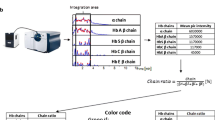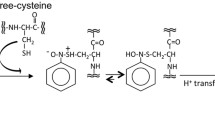Abstract
Proteins are continuously exposed to various reactive chemical species (reactive oxygen/nitrogen species, endogenous/exogenous aldehydes/epoxides, etc.) due to physiological and chemical stresses, resulting in various chemical modifications such as oxidation, nitration, glycation/glycoxidation, lipidation/lipoxidation, and adduct formation with drugs/chemicals. Abundant proteins with a long half-life, such as hemoglobin (Hb, t 1/2 63 days, ∼150 mg/mL), are believed to be major targets of reactive chemical species that reflect biological events. Chemical modifications on Hb have been investigated mainly by mechanistic in vitro experiments or in vivo/clinical experiments focused on single target modifications. Here, we describe an optimized LC/ESI-SRM/MS method to screen oxidized, nitrated, lipidated, and glycated sites on Hb. In vivo preliminary results suggest that this method can detect simultaneously the presence of oxidation (+16 Da) of α-Met32, α-Met76, β-Met55, and β-Trp15 and adducts of malondialdehyde (+54 Da) and glycation (+162 Da) of β-Val1 in a blood sample from a healthy volunteer.

Screening chemical modifications on hemoglobin






Similar content being viewed by others
Abbreviations
- ACTH:
-
Adrenalcorticotropic hormone
- Ang:
-
Angiotensin
- Arg:
-
Arginine
- Asp:
-
Aspartic acid
- Cys:
-
Cysteine
- DHB:
-
2,5-Dihydroxybenzoic acid
- DTT:
-
Dithiothreitol
- ESI:
-
Electrospray ionization
- FA:
-
Formic acid
- Hb:
-
Hemoglobin
- His:
-
Histidine
- HNE:
-
4-Hydroxy-2(E)-nonenal
- IAA:
-
Iodoacetamide
- LC:
-
Liquid chromatography
- Lys:
-
Lysine
- m/z :
-
Mass-to-charge ratio
- MALDI:
-
Matrix-assisted laser desorption ionization
- MDA:
-
Malondialdehyde
- Met:
-
Methionine
- MG:
-
Methylglyoxal
- MG-DH:
-
N δ-(4,5-Dihydroxy-4-methylimidazolidine-2-yl)ornithine
- MG-H1:
-
N δ-(5-Hydro-5-methyl-4-imidazolon-2-yl)ornithine
- MS:
-
Mass spectrometry
- MS/MS:
-
Tandem mass spectrometry
- PBS:
-
Phosphate-buffered saline
- SRM:
-
Selected reaction monitoring
- TEP:
-
1,1,3,3-Tetraethoxypropane
- TFA:
-
Trifluoroacetic acid
- TOF:
-
Time of flight
- Trp:
-
Tryptophan
- Tyr:
-
Tyrosine
- V8:
-
Endoproteinase Glu-C
References
Fred C, Haglund J, Helleberg H, Paulsson B, Rydberg P, Tornqvist M. Protein adducts: quantitative and qualitative aspects of their formation, analysis and applications. J Chromatogr B Anal Technol Biomed Life Sci. 2002;778:279–308. doi:10.1016/S1570-0232(02)00172-1.
Boysen G, Georgieva NI, Upton PB, Walker VE, Swenberg JA. N-terminal globin adducts as biomarkers for formation of butadiene derived epoxides. Chem-Biol Interact. 2007;166:84–92. doi:10.1016/j.cbi.2006.10.005.
Meyer MJ, Bechtold WE. Protein adduct biomarkers: state of the art. Environ Health Perspect. 1996;104:879–82. doi:10.2307/3433005.
Qin Z, Hu D, Han S, Reaney SH, Di Monte DA, Fink AL. Effect of 4-hydroxy-2-nonenal modification on alpha-synuclein aggregation. J Biol Chem. 2007;282:5862–70. doi:10.1074/jbc.M608126200.
Zhan X, Desiderio DM. Nitroproteins from a human pituitary adenoma tissue discovered with a nitrotyrosine affinity column and tandem mass spectrometry. Anal Biochem. 2006;354:279–89. doi:10.1016/j.ab.2006.05.024.
Goto T, Kojima S, Shitamichi S, Lee SH, Oe T. Chemical modificomics: a novel strategy for efficient biomarker discovery through chemical modifications on a target peptide. Anal Methods. 2012;4:1945–52. doi:10.1039/C2AY05841C.
Lee SH, Takahashi R, Goto T, Oe T. Mass spectrometric characterization of modifications to angiotensin II by lipid peroxidation products, 4-oxo-2(E)-nonenal and 4-hydroxy-2(E)-nonenal. Chem Res Toxicol. 2010;23:1771–85. doi:10.1021/tx100228q.
Lee SH, Masuda T, Goto T, Oe T. MALDI-TOF/MS-based label-free binding assay for angiotensin II type 1 receptor: application fornovel angiotensin peptides. Anal Biochem. 2013;437:10–6. doi:10.1016/j.ab.2013.01.023.
Goto T, Murata K, Lee SH, Oe T. Complete amino acid sequencing and immunoaffinity clean-up can facilitate screening of various chemical modifications on human serum albumin. Anal Bioanal Chem. 2013;405:7383–95. doi:10.1007/s00216-013-7146-0.
Goto T, Kudo Y, Lee SH, Oe T. Efficient strategy for screening chemical modifications on human serum albumin: use of LC/MS/MS and differential analysis. Bunseki Kagaku. 2015;64:653–9. doi:10.2116/bunsekikagaku.64.653.
Kajita R, Goto T, Lee SH, Oe T. Aldehyde stress-mediated novel modification of proteins: epimerization of the N-terminal amino acid. Chem Res Toxicol. 2013;26:1926–36. doi:10.1021/tx400354d.
Osaki F, Goto T, Lee SH, Oe T. Predicted multiple selected reaction monitoring to screen activated drug-mediated modifications on human serum albumin. Anal Biochem. 2014;449:59–67. doi:10.1016/j.ab.2013.12.016.
Lee SH, Miyamoto K, Goto T, Oe T. Non-invasive proteomic analysis of human skin keratins: screening of methionine oxidation in keratins by mass spectrometry. J Proteomics. 2011;75:435–49. doi:10.1016/j.jprot.2011.08.010.
Lee SH, Matsushima K, Miyamoto K, Oe T. UV irradiation-induced methionine oxidation in human skin keratins: mass spectrometry-based non-invasive proteomic analysis. J Proteomics. 2016;133:54–65. doi:10.1016/j.jprot.2015.11.026.
Lee SH, Matsushima K, Miyamoto K, Oe T. Mass spectrometry data from proteomic analysis of human skin keratins after exposure to UV radiation. Data Brief. 2016;7:100–6. doi:10.1016/j.dib.2016.02.008.
Peters Jr T. All about albumin: biochemistry, genetics, and medical applications. San Diego: Academic; 1996. ISBN 0- 12-552110-3.
Cox GN, Smith DJ, Carlson SJ, Bendele AM, Chlipala EA, Doherty DH. Enhanced circulating half-life and hematopoietic properties of a human granulocyte colony-stimulating factor/immunoglobulin fusion protein. Exp Hematol. 2004;32:441–9. doi:10.1016/j.exphem.2004.01.012.
Shapiro R, Mcmanus MJ, Zalut C, Bunn HF. Sites of nonenzymatic glycosylation of human hemoglobin A. J Biol Chem. 1980;255:3120–7.
Chen HJC, Chen YC. Reactive nitrogen oxide species-induced post-translational modifications in human hemoglobin and the association with cigarette smoking. Anal Chem. 2012;84:7881–90. doi:10.1021/ac301597r.
Xiang W, Weisbach V, Sticht H, Seebahn A, Bussmann J, Zimmermann R, et al. Oxidative stress-induced posttranslational modifications of human hemoglobin in erythrocytes. Arch Biochem Biophys. 2013;529:34–44. doi:10.1016/j.abb.2012.11.002.
Kautiainen A, Tornqvist M, Svensson K, Osterman-Golkar S. Adducts of malonaldehyde and a few other aldehydes to hemoglobin. Carcinogenesis. 1989;10:2123–30. doi:10.1093/carcin/10.11.2123.
Chen HC, Lin W, Chiu S, Fan C. Multistage mass spectrometric analysis of human hemoglobin glutathionylation: correlation with cigarette smoking. Chem Res Toxicol. 2014;27:864–72. doi:10.1021/tx5000359.
Chevolleau S, Jacques C, Canlet C, Tulliez J, Debrauwer L. Analysis of hemoglobin adducts of acrylamide and glycidamide by liquid chromatography-electrospray ionization tandem mass spectrometry, as exposure biomarkers in French population. J Chromatogr A. 2007;1167:125–34. doi:10.1016/j.chroma.2007.07.044.
Zhang F, Brzak K, Pottenger LH, Bartels MJ. Direct quantitation of hydroxyethylvaline in hemoglobin by liquid chromatography/positive electrospray tandem mass spectrometry. J Chromatogr A. 2012;1248:84–92. doi:10.1016/j.chroma.2012.05.019.
Ospina M, Costin A, Barry AK, Vesper HW. Characterization of N-terminal formaldehyde adducts. Rapid Commun Mass Spectrom. 2011;25:1043–50. doi:10.1002/rcm.4954.
Antunes AM, Godinho AL, Martins IL, Oliveira MC, Gomes R, Coelho AV, et al. Protein adducts as prospective biomarkers of nevirapine toxicity. Chem Res Toxicol. 2010;23:1714–25. doi:10.1021/tx100186t.
Charneira C, Godinho AL, Oliveira MC, Pereira SA, Monteiro EC, Marques MM, et al. Reactive aldehyde metabolites from the anti-HIV drug abacavir: amino acid adducts as possible factors in abacavir toxicity. Chem Res Toxicol. 2011;24:2129–41. doi:10.1021/tx200337b.
Rahbar S. The discovery of glycated hemoglobin: a major event in the study of nonenzymatic chemistry in biological systems. Ann N Y Acad Sci. 2005;1043:9–19. doi:10.1196/annals.1333.002.
Chen HJC, Chen YC, Hsiao CF, Chen PF. Mass spectrometric analysis of glyoxal and methylglyoxal-induced modifications in human hemoglobin from poorly controlled type 2 diabetes mellitus patients. Chem Res Toxicol. 2015;28:2377–89. doi:10.1021/acs.chemrestox.5b00380.
Sabbioni G, Liu YY, Yan H, Sepai O. Hemoglobin adducts, urinary metabolites and health effects in 2,4,6-trinitrotoluene exposed workers. Carcinogenesis. 2005;26:1272–9. doi:10.1093/carcin/bgi078.
Flack SL, Fent KW, Gaines LG, Thomasen JM, Whittaker SG, Ball LM, et al. Hemoglobin adducts in workers exposed to 1,6-hexamethylene diisocyanate. Biomarkers. 2011;16:261–70. doi:10.3109/1354750X.2010.549242.
Fenaille F, Mottier P, Turesky RJ, Ali S, Guy PA. Comparison of analytical techniques to quantify malondialdehyde in milk powders. J Chromatogr A. 2001;921:237–45. doi:10.1016/S0021-9673(01)00883-4.
Schöneich C, Sharov VS. Mass spectrometry of protein modifications by reactive oxygen and nitrogen species. Free Radic Biol Med. 2006;41:1507–20. doi:10.1016/j.freeradbiomed.2006.08.013.
Alvarez B, Rubbo H, Kirk M, Barnes S, Freeman BA, Radi R. Peroxynitrite-dependent tryptophan nitration. Chem Res Toxicol. 1996;9:390–6. doi:10.1021/tx950133b.
Sarver A, Scheffler NK, Shetlar MD, Gibson BW. Analysis of peptides and proteins containing nitrotyrosine by matrix-assisted laser desorption ionization mass spectrometry. J Am Soc Mass Spectrom. 2001;12:439–48. doi:10.1016/S1044-0305(01)00213-6.
Ishii Y, Ogara A, Katsumata T, Umemura T, Nishikawa A, Iwasaki Y, et al. Quantification of nitrated tryptophan in proteins and tissues by high-performance liquid chromatography with electrospray ionization tandem mass spectrometry. J Pharm Biomed Anal. 2007;44:150–9. doi:10.1016/j.jpba.2007.01.012.
Doorn JA, Petersen DR. Covalent modification of amino acid nucleophiles by the lipid peroxidation products 4-hydroxy-2-nonenal and 4-oxo-2-nonenal. Chem Res Toxicol. 2002;15:1445–50. doi:10.1021/tx025590o.
Ishii T, Kumazawa S, Sakurai T, Nakayama T, Uchida K. Mass spectroscopic characterization of protein modification by malondialdehyde. Chem Res Toxicol. 2006;19:122–9. doi:10.1021/tx050231p.
Brock JW, Cotham WE, Thorpe SR, Baynes JW, Ames JM. Detection and identification of arginine modifications on methylglyoxal-modified ribonuclease by mass spectrometric analysis. J Mass Spectrom. 2007;42:89–100. doi:10.1002/jms.1144.
Higgins PJ, Bunn HF. Kinetic analysis of the nonenzymatic glycosylation of hemoglobin. J Biol Chem. 1981;256:5204–8.
Folk JE. The influence of the lysine-glucose reaction on enzymatic digestion. Arch Biochem Biophys. 1956;64:6–18. doi:10.1016/0003-9861(56)90236-3.
Gadgil HS, Bondarenko PV, Treuheit MJ, Ren D. Screening and sequencing of glycated proteins by neutral loss scan LC/MS/MS method. Anal Chem. 2007;79:5991–9. doi:10.1021/ac070619k.
Bose T, Bhattacherjee A, Banerjee S, Chakraborti AS. Methylglyoxal-induced modifications of hemoglobin: structural and functional characteristics. Arch Biochem Biophys. 2013;529:99–104. doi:10.1016/j.abb.2012.12.001.
Sun S, Zhou JY, Yang W, Zhang H. Inhibition of protein carbamylation in urea solution using ammonium-containing buffers. Anal Biochem. 2014;446:76–81. doi:10.1016/j.ab.2013.10.024.
Yang Z, Attygalle AB. LC/MS characterization of undesired products formed during iodoacetamide derivatization of sulfhydryl groups of peptides. J Mass Spectrom. 2007;42:233–43. doi:10.1002/jms.1157.
Acknowledgments
This work was supported in part by a Grant-in-Aid for Challenging Exploratory Research (to T.O., No. 15 K14935 for 2015–2016) from the Japan Society for the Promotion of Science. The authors are indebted to Professor Ian A. Blair (University of Pennsylvania, Philadelphia, PA) and Astellas Pharma Inc. (Analysis and Pharmacokinetics Research Labs, Tsukuba, Japan) for donating a used LCQ Deca and API2000, respectively. We also thank the Biomedical Research Core (School of Medicine) at Tohoku University for the use of their MALDI-TOF/MS instrument.
Author information
Authors and Affiliations
Corresponding author
Ethics declarations
Conflict of interest
The authors declare that there are no conflicts of interest.
Human and animal rights and informed consent
This study was approved by the Human Research Ethics Committee, Graduate School of Pharmaceutical Sciences, Tohoku University, on Aug. 10, 2012 (term 2012–2017, registration #12-03, “Chemical modificomics on abundant proteins”). A blood sample was obtained from a healthy volunteer who provided written informed consent.
Electronic supplementary material
Below is the link to the electronic supplementary material.
ESM 1
(PDF 204 kb)
Rights and permissions
About this article
Cite this article
Kojima, K., Lee, S.H. & Oe, T. An LC/ESI-SRM/MS method to screen chemically modified hemoglobin: simultaneous analysis for oxidized, nitrated, lipidated, and glycated sites. Anal Bioanal Chem 408, 5379–5392 (2016). https://doi.org/10.1007/s00216-016-9635-4
Received:
Revised:
Accepted:
Published:
Issue Date:
DOI: https://doi.org/10.1007/s00216-016-9635-4




